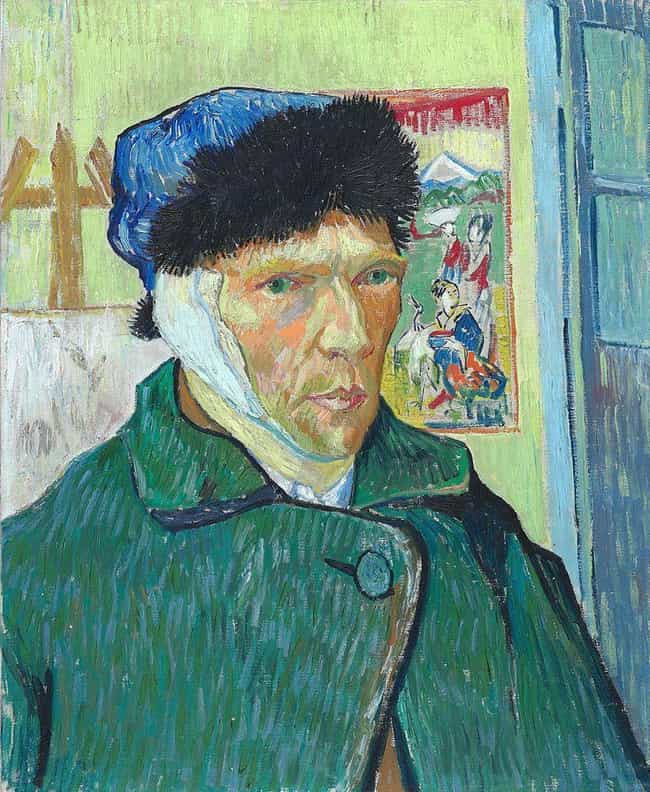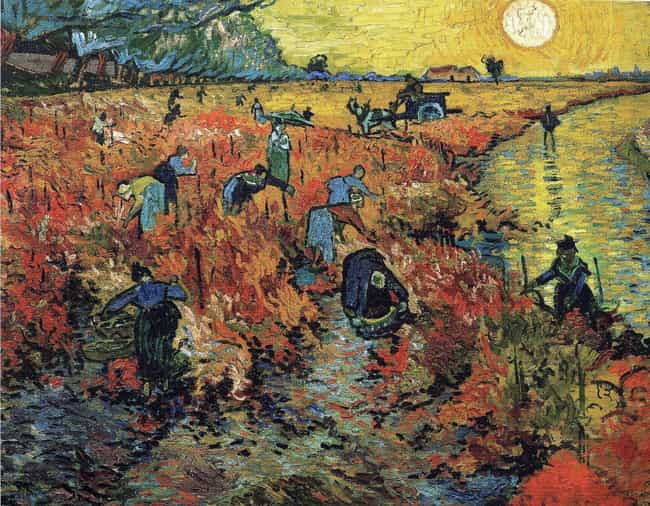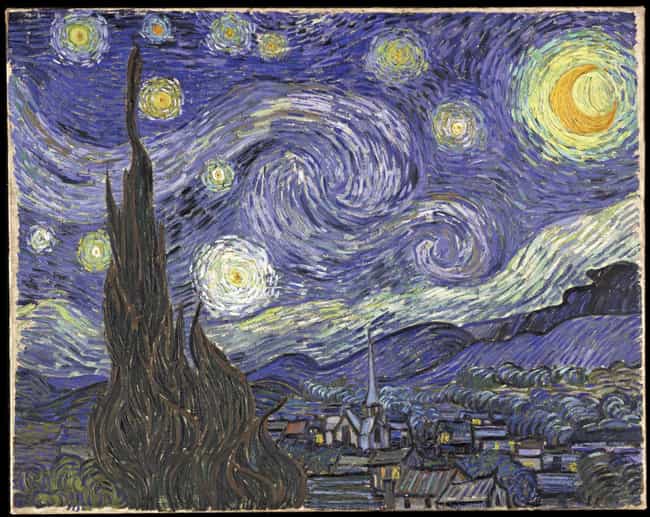 |
| Self-Portrait with a Straw Hat, 1887. Vincent van Gogh |
He Cut Off His Ear Lobe In An Attempt To Win Back A Friend
In the summer of 1888, Vincent van Gogh left the city of Paris and headed to the Provence region of France. Supported financially by his art-dealer brother Theo, he ultimately settled in the ancient town of Arles, where he rented a large yellow house and began to dream of establishing an artist colony where he and other like-minded painters could live and create. Theo and Vincent were acquainted with Paul Gauguin, another cutting-edge impressionist that both men admired professionally. It took some persuasion, but in October of 1888, Gauguin agreed to move to the Yellow House, and initially the two artists functioned reasonably well together. Gauguin was a streetwise, former stock exchange worker, and van Gogh was a troubled and talented young man. Unfortunately, the acerbic and condescending Gauguin and the sensitive, needy Vincent van Gogh quickly began to get on each other's nerves. What little money they had was consumed by drinking and visits to nearby brothels. Eventually, sensing correctly that Gauguin was preparing to abandon him and their "artistic colony," Van Gogh descended into drunken agitation and hostility.
According to Gauguin, on December 23, after another savage argument, he moved out and checked into a hotel when Van Gogh threatened him with a knife. Supposedly, Van Gogh sliced off much of his left ear lobe, walked to a familiar brothel and presented the bloody appendage to a prostitute named Rachel, who fainted on the spot. Because Gauguin's self-serving account is the only perspective that remains, speculation continues around what exactly happened and who exactly cut off Van Gogh's ear. A recent theory is that Gauguin, an accomplished fencer, actually lopped off the ear during the pair's final argument. Whatever the case, Van Gogh evaded police on the night of the 23rd but, because they knew of his eccentric identity, they eventually made it to the Yellow House, where they discovered him in his blood soaked bed. Van Gogh was taken to the hospital and eventually committed himself to a mental asylum. Gauguin noticed the police activity when he returned and left Arles on Christmas Day, informing Theo of his brother's condition while en route to Paris.
Although the two artists would never see each other again, they would continue to correspond. With his typical arrogance, within weeks, Gauguin sent Van Gogh a letter requesting that Vincent give him back paintings that he had previously gifted.
In 1889, Vincent van Gogh was invited to exhibit at Les XX, an annual art show in Brussels sponsored by 20 local artists who displayed their own work as well as the work of 20 invitees. Vincent submitted three landscapes, two sunflower studies and a painting, titled The Red Vineyard. Anna Boch, the sister of a friend of Van Gogh, Eugene Boch, paid 400 francs for the painting (about $80 in 1890). Because Van Gogh's work was greeted by many in the art community with derision, Anna wished to encourage him with the purchase. Although Van Gogh may have sold some drawings and works unofficially, this is the only publicly recorded sale that occurred in his lifetime. Today, The Red Vineyard hangs in the Pushkin Museum in Moscow, having been nationalized from a Russian collector after the revolution.
After a psychotic breakdown, Van Gogh voluntarily committed himself to the Saint-Paul Asylum in St. Remy-de-Provence in May of 1889. Although he was not allowed to paint in his actual bedroom, he was granted studio space in another room. Many of the paintings that he continued to turn out during this prolific period were merely landscapes of the view from his asylum room, minus the bars. For what is considered to be his most famous painting, The Starry Night, he was allowed to sketch a nightscape, which he then transformed during the day. The swirling skies and aura around the stars have been interpreted as everything from the symbolism of infinity to the hallucinations resulting from Van Gogh's mental illness. Van Gogh thought so little of The Starry Night that he withheld it from the batches of paintings he routinely sent to his brother to sell in Paris because he wanted to save money on postage. Of the painting he commented in a letter:
"I have been slaving away on nature the whole year, hardly thinking of impressionism or of this, that and the other. And yet, once again I let myself go reaching for stars that are too big - a new failure - and I have had enough of it."
Without Theo van Gogh, there would have never been the artist Vincent van Gogh. Initially, when they were employed by the same art dealer, it was Theo who encouraged his brother to pursue art as a vocation. Because his instability and even mental illness made him virtually unemployable, most of Vincent's financial support came from Theo. Theo van Gogh was also a strong proponent of Impressionist art and artists when this school of painting was still relatively undiscovered. Vincent van Gogh lived with Theo in Paris from 1886 until 1888, and, through Theo's business contacts, he met some of the most prominent artists of the time period including Toulouse-Lautrec, Pissarro, Seurat, Cezanne, and the aforementioned Gauguin. Theo and Vincent's remarkable relationship and Theo's unflagging encouragement and emotional support are chronicled in the numerous letters that they exchanged. Fortunately these letters were preserved and reprinted in the 20th century. During his lifetime, Theo was discussing his brother with another artist friend and commented:
"I should not be surprised if my brother were one of the great geniuses and will one day be compared to someone like Beethoven."
Time proved Theo correct.
One Of His Final Paintings Depicts The Field Where He Committed Suicide
In the the three months of his tenure at Auvers-Sur-Oise, Vincent van Gogh composed 70 paintings, many of them his most famous works. On July 27, 1890, Van Gogh made his way to the wheat fields just north of his residence at an inn in Auvers-Sur-Oise. He had borrowed a pistol from his innkeeper, ostensibly to scare off crows while he was painting; instead, he is believed to have turned the gun on himself. Coincidentally, one of Van Gogh's final paintings is the haunting and symbolic Wheatfield With Crows, an abstract work filled with black crows, paths leading nowhere, and ominous skies. It depicts the field where Van Gogh attempted to kill himself. Wounding himself in the chest, he would stumble back to his inn, say little about what he had done, and die 30 hours later with his brother Theo at his side. The cemetery that Vincent and Theo are buried in is only a few hundred feet from this vantage point.
His Therapist Made Off With Millions Of Dollars Worth Of Van Gogh's Art When He Died
He Only Had One Romantic Relationship In His Entire Life
Vincent van Gogh was not so reclusive and socially inept that he didn't attempt to romance and even marry female acquaintances that he encountered. While living in England in his early 20s, he was rebuffed by the daughter of a landlady who was engaged to another man. He was also famously rejected by his first cousin with the phrase "No, nay never." In what sounds like a nineteenth century version of a stalker, he showed up in Amsterdam to continue the pursuit to the extent that his cousin would not even agree to see him.
In 1882, in The Hague to study drawing with a friend, Van Gogh made the acquaintance of a seamstress and prostitute named Clasina Maria Hoornink. Hoornink had a five-year-old daughter and was expecting a child fathered by a man who had abandoned her. Eventually, she would move in with Van Gogh, the only domestic relationship he enjoyed in his lifetime. Although he told Theo he wanted to marry the woman, after his apoplectic pastor father demanded he end the relationship, and his brother sensibly advised the same, Vincent eventually left Clasina Hoornink - but not before she gave Vincent a dose of gonorrhea. She subsequently gave her children to family members to raise and eventually committed suicide by hurling herself into a Rotterdam canal in 1904. Some historians have attempted to connect her son's paternity to Vincent, but it is pretty clear that the dates don't match up.
Vincent van Gogh's parents had six children: three sons and three daughters. Of these six, Vincent struggled with mental illness for his entire adult life and ended it in suicide. Theo van Gogh died under mysterious circumstances that are historically obscure but may have been related to syphilis, suicide, or mental illness. The third brother, Cornelius, was 14 years younger than Vincent and lived in South Africa. After his marriage disintegrated, he enlisted during the Boer-British conflict, was captured, and committed suicide at 33. Wilhemina van Gogh would spend the last four decades of her life in a mental institution, suffering from conditions that were similar to Vincent's maladies.
The Nazis Declared Him A 'Degenerate'
Vincent van Gogh was one of many artists that the Nazis declared "degenerate." Not content to merely remove certain paintings and artists from the state's museums, they went so far as to organize auctions to sell off such artwork en masse. One of the works caught up in this process was a self portrait by Van Gogh that is among his most famous works. Not only is the jade background a striking color, but the almost oblong skull of Van Gogh also makes the painting an unusual rendition and an unmistakable image. But it is the historical context of the painting that really makes it unique. The official title of the painting is Self Portrait Dedicated To Paul Gauguin. Van Gogh painted it in 1888, inscribed it "A Mon Ami Paul," and sent it to Gauguin at the artist's home in Brittany, in the hope it would induce him to come to the proposed "artist's colony" in Arles.
Despite their falling out, Gauguin must have liked the painting because he kept it until 1897 when, attempting to raise money for one of his Polynesian excursions, he pawned it to a Parisian art dealer who subsequently sold it for 300 francs. Thinking that the inscription would lessen the sales price, someone, probably Gauguin, obscured the dedication, which is still faintly visible in the upper portion of the painting. When the painting was auctioned off in Lucerne, in 1939, it went for 12,000 pounds, a surprisingly high price. Purchased by banker Maurice Wertheim, upon his death, it was bequeathed to Harvard University, where it hangs in the Fogg Art Museum.
Van Gogh's Last Innkeeper Sold His Two Van Gogh Paintings For Forty Francs
Arthur Ravoux was the innkeeper who housed Vincent van Gogh at the Auberge Ravoux for the last three months of the artist's life. His family got to know the artist who took his meals with them and whose absence at dinner on the day he attempted suicide indicated something was seriously wrong. Upon Van Gogh's death, Arthur Ravoux, not wanting to appear grasping, refused any additional paintings from Theo, save for the two he already possessed, a portrait of his daughter Adeline and a landscape of the Auvers town hall, which was across the street and which Van Gogh painted from the street in front of the inn.
Both paintings were displayed in the Auberge until the Ravoux family moved to the town of Meulan and operated a cafe there. In 1905, two American artists staying in Meulan heard that Arthur Ravoux had two Van Goghs and asked to see them. When they mentioned that the paint was already deteriorating and he should give the artworks to them to be preserved properly, Ravoux demanded that he be paid something despite his belief that the paintings were virtually worthless. They quickly settled on a price: 40 francs, about 10 American dollars.
Among Other Failures, Van Gogh Was An Unsuccessful Evangelist
In 1879, Van Gogh, wishing to emulate his father who was a church pastor, was able to secure a position as an evangelical missionary in the Borinage, a poor mining region in Belgium. One of Van Gogh's criticisms of theology, which he studied, was that it was merely words and not actions. To better commune with the members of his impoverished community, Van Gogh gave away his clothing and allowed a homeless person to assume his lodgings while he slept in a crude hut. His fervent attitude did not endear him to church officials who declined to rehire him when his six-month contract expired. Van Gogh also spent his spare time composing drawings, but most of these early works have disappeared.
His Sister-In-Law Helped Popularize Van Gogh
Johanna "Jo" van Gogh-Bonger was born in Amsterdam in 1862. She was introduced by her brother to Theo van Gogh who immediately proposed, a proposal that was eventually accepted in 1889. In fact, her marriage and subsequent delivery of a son may have been the main factors in Vincent's decision to commit suicide, believing that Theo, with a growing family, would soon be unable to support him. With Theo's death shortly after Vincent's, it was left to Jo van Gogh to make something of the then-worthless artistic legacy and collected letters of both Vincent and Theo. Through her promotion of Vincent's work with prominent art dealers and her publication of Letters To Theo, a public fascination with the work and life of Vincent van Gogh began - a fascination that has never subsided. With her death, her son Vincent Willem, named after his illustrious uncle, continued her work and established the foundation that is responsible for the Vincent van Gogh Museum in Amsterdam.
Vincent's Death Sent His Brother Into A Downward Spiral
Following the death of Vincent, Theo van Gogh seems to have gone into a profoundly negative health spiral. By November of 1890, he was a patient at a psychiatric hospital near Utrecht, Holland, having left Paris to be hospitalized near family members. He died in hospital on January 25, 1891, aged 33. His death has been attributed to many factors including syphilis-induced dementia, suicide, and severe depression over his brother's death. Whatever the specific cause, Theo's condition was deemed serious enough to confine him to a mental institution. Initially buried in Utrecht, recognizing the remarkable bond between Vincent and Theo, Theo's widow had his remains exhumed and reburied next to Vincent at the cemetery in Auver-Sur-Oise.
At One Time, A Van Gogh Was The Most Expensive Painting In The World
In 1990, one of the two Van Gogh Portrait of Dr. Gachet paintings was removed by its owners, the Kramarsky family, to be auctioned. The painting was one of several Van Gogh's owned by banker Siegfried Kramarsky, who died in 1961. Kramarsky bought the painting when the Nazi government purged it from a Frankfurt art museum and ordered it sold. The subsequent May 15, 1990 Christie's auction caused a sensation in the art world when a Japanese industrialist, Ryoei Saito, bid $82.5 million, way over the expected $40 million and a record price. A day later Saito bought a Renoir for $78.1 million. Saito also irritated many by placing the painting in his private office and declaring that, upon his death, he would be cremated clutching the portrait in his arms. Subsequently, Saito experienced severe financial difficulties, and the painting was reportedly sold. Its whereabouts are unknown. The Van Gogh record price would stand until May 2004 when it was broken by Picasso's Boy With A Pipe, which sold for $93 million
















No comments:
Post a Comment